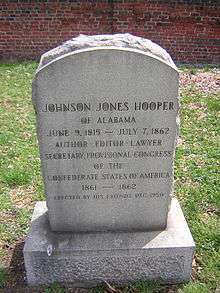Johnson J. Hooper

Johnson Jones Hooper (June 9, 1815 – June 7, 1862) was an American humorist.[1]
Biography
Hooper was born in Wilmington, North Carolina as the youngest of three sons of Archibald Maclaine Hooper and Charlotte de Bernier Hooper.[2] He moved to Dadeville, Alabama in 1835 where he edited a newspaper and practiced law. All told, he founded or edited six different publications during his career.
His first published work, in 1843, was "Taking the Census in Alabama", drawn from his own experiences as a census taker in Tallapoosa County.[3] In 1844 he began publishing short stories about the rascally Simon Suggs, which he collected and published in 1845 as the Adventures of Captain Simon Suggs; broadly, cruelly, and uncouthly humorous, yet one of the raciest books of its time, descriptive of a gambling sharp of the Southwest in the "flush times."[4] The work made him nationally known, and may have inspired one or more characters of Mark Twain's. His Widow Rugby's Husband and Other Tales of Alabama (1851) was less successful.[5]
Intensely political, he was appointed secretary of the Provisional Confederate Congress in 1861.[6] He moved with the Confederate government to Richmond, where he died from the effects of tuberculosis in 1862 (not 1861, as indicated on the state historical marker) and was buried in that city's Shockoe Hill Cemetery. His grave was unmarked until 1950, when anonymous donors erected the current granite stone.
He married Mary Mildred Brantley in 1845. They had two sons, William and Adolphus.[7]
Trivia
Thomas A. Burke dedicated his book of humorous tales Polly Peablossom's Wedding (1854) to Hooper.[8]
David Handlin listed Some Adventures of Captain Simon Suggs at number 9 in his article "One Hundred Best American Novels, 1770 to 1985".[9]
Works
- Some Adventures of Captain Simon Suggs, Late of the Tallapoosa Volunteers. Philadelphia: Carey & Hart, 1845 (Rpt. as Adventures of Captain Simon Suggs, Late of the Tallapoosa Volunteers. Chapel Hill: University of North Carolina Press, 1969; Tuscaloosa, University of Alabama Press, 1993).
- A Ride with Old Kit Kuncker, and Other Sketches, and Scenes of Alabama. Tuscaloosa: M. D. J. Slade, 1849 (Rpt. as The Widow Rugby's Husband. Philadelphia: A. Hart, 1851).
- Dog and Gun. New York: Orange Judd & Company, 1856 (Rpt. Tuscaloosa: University of Alabama Press, 1992).
Notes
- ↑ Treadaway, James L. (1983). "Johnson Jones Hooper and the American Picaresque," Thalia 6, pp. 33-42.
- ↑ Tate, Adam L. (2005). Conservatism and Southern Intellectuals, 1789-1861. University of Missouri Press, p. 262.
- ↑ Tate (2005), p. 263.
- ↑ Rachal, John (1976). "Language and Comic Motifs in Johnson Jones Hooper's Simon Suggs" Alabama Historical Quarterly 38, pp. 93-100.
- ↑ White, Cynthia Quinn (2010). "Johnson Jones Hooper," The Encyclopedia of Alabama.
- ↑ Somers, Paul, Jr. (1984). Johnson J. Hooper. Boston: Twayne Publishers.
- ↑ Hoole, W. Stanley (1952). Alias Simon Suggs: The Life and Times of Johnson Jones Hooper. University of Alabama Press, p. 41.
- ↑ Polly Peablossom's Wedding. Philadelphia: Getz & Buck, 1854.
- ↑ Handlin, David (2014). "One Hundred Best American Novels, 1770 to 1985", The American Scholar.
![]() This article incorporates text from a publication now in the public domain: Gilman, D. C.; Peck, H. T.; Colby, F. M., eds. (1905). "article name needed". New International Encyclopedia (1st ed.). New York: Dodd, Mead.
This article incorporates text from a publication now in the public domain: Gilman, D. C.; Peck, H. T.; Colby, F. M., eds. (1905). "article name needed". New International Encyclopedia (1st ed.). New York: Dodd, Mead.
Further reading
- Cymbalsky, Stephen (sic). 'Literature' in "Time, Talent, and Tradition: Five Essays on the Cultural History of the Lower Cape Fear Region", Edited by Janet K. Seapker. Wilmington, NC, Museum of the Lower Cape Fear, 1995
- Hopkins, Robert (1963). "Simon Suggs: A Burlesque Campaign Biography," American Quarterly 15 (3), pp. 459–463.
- Inge, M. Thomas (2001). The Humor of the Old South. University Press of Kentucky.
- Phillips, Robert. L, Jr. (1987). "Johnson Jones Hooper (1815-1862)." In: Fifty Southern Writers Before 1900: A Bio-Bibliographical Sourcebook, edited by Robert Bain and Joseph M. Flora. Westport, Conn.: Greenwood Press.
- Sharp, Ann Wyatt (1986). "Some Adventures of Captain Simon Suggs: The Legacy of Johnson Jones Hooper." In: No Fairer Land: Studies in Southern Literature Before 1900, edited by J. Lasley Dameron and James W. Matthews. Troy, N.Y.: Whitson Publishing.
- Shields, Johanna (1990). "A Sadder Simon Suggs: Freedom and Slavery in the Humor of Johnson Jones Hooper," Journal of Southern History 56, pp. 641–64.
- Williams, Benjamin Buford (1979). "Johnson Jones Hooper, 'Alias Simon Suggs'." In: A Literary History of Alabama: The Nineteenth Century. Rutherford, N.J.: Fairleigh Dickinson University Press, pp. 69–82.
External links
- Works by Johnson J. Hooper, at Hathi Trust
- Johnson Jones Hooper
- Historical Marker Database - Johnson J. Hooper